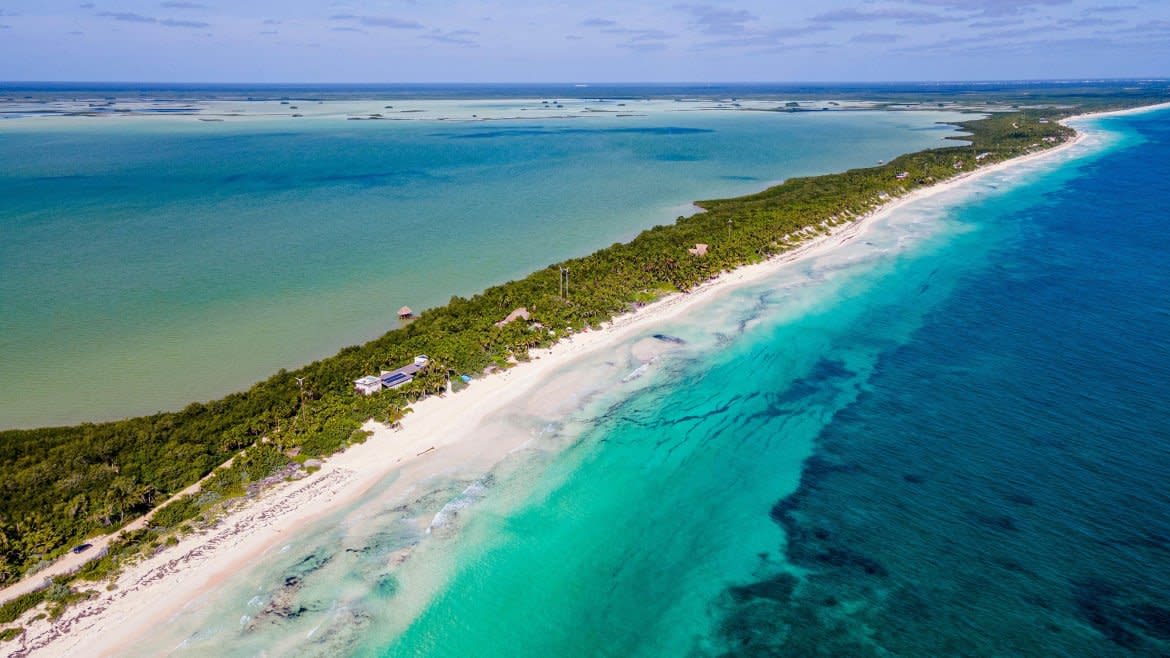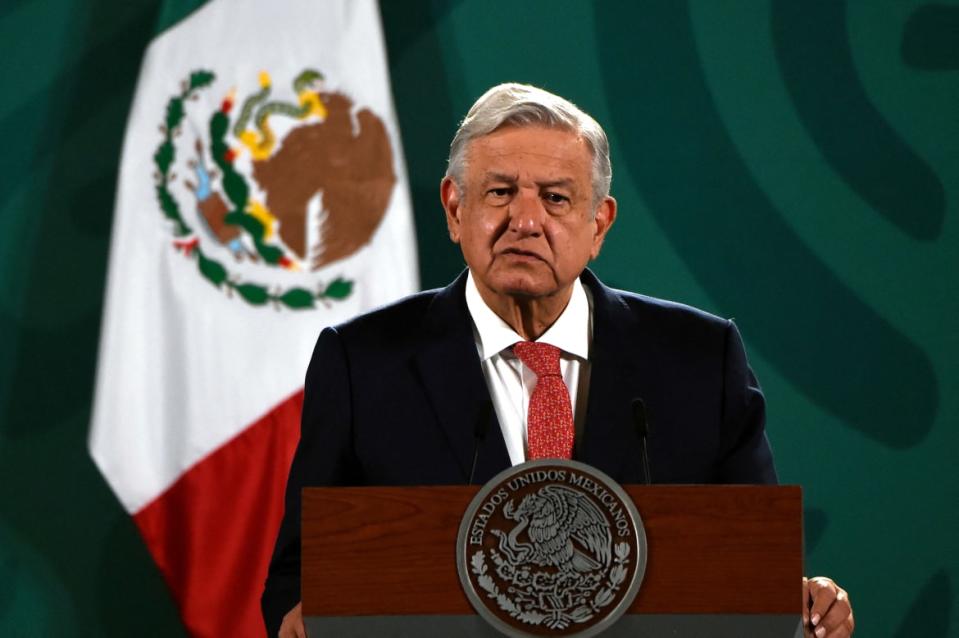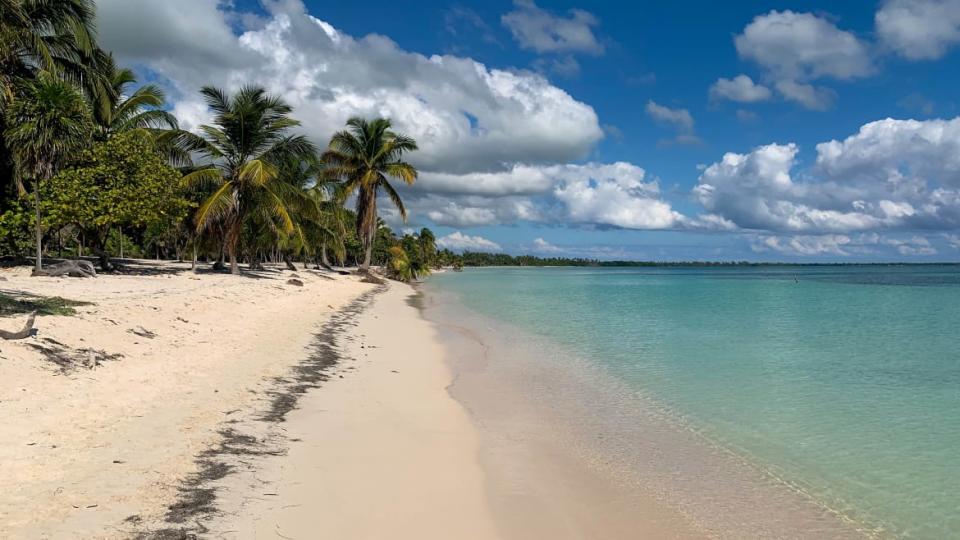This Mexican Preserve Is the Anti-Tulum. Is That About to Change?

- Oops!Something went wrong.Please try again later.
Alfaro Yam Canul motioned forward toward a stretch of dirt heading east from his hometown to a bay on the Caribbean Sea.
“It’s ugly,” he said, referring not to the scenery—the outskirts of the Sian Ka’an nature reserve, a UNESCO World Heritage site where dense jungle gives way to turquoise canals and habitats for big cats and rare birds—but to the road itself, which is marked by potholes and patches of mud that slow the rare car crossing it to a crawl.
Just 25 miles separate Felipe Carillo Puerto, a Mayan city with a pivotal role in the people’s history, and the beach on the edge of the reserve, though the condition of the road creates a nearly five-hour journey that’s hardly ever taken.
That means the city is choked off from the lucrative coastline, located at the tail end of the Mayan Riviera and just south of Tulum, where seaside ruins draw international crowds to one of Mexico’s most popular vacation spots.
In the spring, Yam Canul, a stout man with a serious face and a rebel’s red-starred cap, took his frustration as high as it goes in Mexico, in an encounter with the country’s president that was broadcast on national television.
“We realize that we have a great history, that we are always used as an example, and that people make a lot of money from our name. But that money isn’t seen by the indigenous communities in the state,” he told President Andrés Manuel López Obrador.

Mexican President Andres Manuel Lopez Obrador.
The solution Yam Canul proposed — to open up the Sian Ka’an reserve for development by the region’s Mayans — exposes a complicated history of the tourism hotspot, where indigenous rights, commercial interests, and environmental stewardship have vied for prioritization over decades.
Before 1986, when the federal government, amid a wave of conservation in the country, designated the area a protected biosphere and walled it off from most outsiders, Sian Ka’an, Mayan for “the place where the sky is born,” was a source of livelihood for the native population.
Crocodiles and sea turtles were food for the indigenous communities. From the animals’ skin and shells, they made clothing and medicine. Canals cut from freshwater lagoons to the Caribbean Sea were part of a trading route that extended down to Belize and Guatemala.
The water there is so clear and clean that local Mayans still drink from it, said Antonio Caamal, a boat pilot with Community Tours Sian Ka’an, who on a recent afternoon carried a trio of visitors through the reserve’s waterways.
From a seat in the motorized skiff, the wildlife in the 2,000 square-mile park changes quickly. Far-reaching lagoons surrounded by forest lead into canals lined with tall savannah grass. Jaguars, tapirs, and wild boars hide out from the afternoon sun on wooded islands while herons fly overhead.
At the top of a canal crowded with mangroves, Caamaal dropped his passengers for an hour-long float. Propped on their backs with life jackets, a light current wound them through the shallow channel.
The tours, one of the few activities permitted in the reserve, are a respite for the over-stimulated in Tulum, whose rapid development in recent years has harmed its storied boho vibe. They’re also one of the only employment opportunities for the indigenous outside of the region’s sprawling resorts.
Before the pandemic, Community Tours Sian Ka’an employed 53 people from its base in Muyil, a Mayan cooperative south of Tulum with a main inland entrance into the reserve. The organization is part of an alliance of two dozen businesses across the Yucatan peninsula that promotes this kind of locally-led tourism.
“The idea is to generate a circular economy where people can work in their community and receive a decent economic benefit,” said Román Caamal, the general director of the group and a cousin of Antonio, the guide.
Since government programs in the 1970s began transforming the jungles of Quintana Roo, tourism has dominated the region’s economy, with foreign developers building big complexes along the white sand beaches. The state’s tourist zone—stretching from the tip of the peninsula down the coast, through Cancun, Playa del Carmen, and ending at Tulum—is home to 90 percent of its wages.
For a worker living in the state’s Mayan communities to the south, the commute to a service job in the Mayan Riviera can easily top an hour each way.
“If they go and return in the same day, it takes a very strong physical toll. If they stay up there, it’s an uprooting from their community and their family,” said Victoria Santos, a member of Consejo Ciudadano para la Defensa y Rescate de Sian Ka’an, a Mayan organization that lobbies to open the reserve.
Over a lunch of salty shredded venison and a tart and fleshy dragonfruit juice at Restaurante el Faisan y el Venado, a central gathering place in Felipe Carillo Puerto, Santos and Yam Canul outlined the group’s vision.
The terms of the 1986 decree creating the park would be revised, shifting its management from a federal commissioner, a biologist, into the hands of the indigenous community; conservation would remain a priority, while outposts for research and education would bring visitors into the effort; and a new entrance into the park via a well-paved road from Felipe Carillo Puerto would connect the city to the coastline. Relaxed development regulations would allow for the construction of small seafront restaurants and shops.
Santos and her organization argue that tapping into the resources of the park won’t drain it, but will instead lead to a greater state of community care.
“We understand that protection is not about non-use. If you stop wearing a shoe, whether it’s wet or dry, if it’s not used, it will fall apart,” she said.
Central to the project is Felipe Carillo Puerto, the municipal capital that Yam Canul and Santos want to see built up as a base camp for exploration into the park. With new hotels and amenities for tourists, the small city would be a destination of its own, competing to draw visitors and jobs from the resort towns to the north.
From its founding, Felipe Carillo Puerto has been a seat of Mayan resistance against outside forces.
In 1850, Mayan rebels were losing ground to the Yucateco army in the peninsula’s Guerra de Castas, or Caste War, when a mysterious voice coming from behind a cross in the center of a nascent Felipe Carillo Puerto began to urge the indigenous fighters on.
The divine message (later determined to be the work of a ventriloquist) inspired the Mayans, who defended an independent state into a period of stalemate that lasted more than 50 years, when the Mexican army mounted a successful invasion.
Today, a church at the site of the Talking Cross still offers services to the city’s religious each morning. The cenote where the holy imposter first hid to stage his call to arms rests beneath it.
Lodging is available in the city at a small number of modest hotels, including the brightly-colored Hotel “Esquivel” La Casona on the main square.
More adventurous travelers will prefer Siijil Noh Ha, a waterside compound a short drive to the south. A half-dozen cabins around a small lagoon there are not air conditioned, but sleep comes easy after a day exploring on a rented kayak and a dip in the water.
A stay in the Sian Ka’an reserve itself is more difficult to come by, but the handful of properties along its coastline are unlike anything else in the area.
Reached by a dirt road that continues past the end of Tulum’s cluttered hotel zone, the outer edge of the reserve is a shock of nature—flanked by thick palms that break without warning to reveal extraordinary swaths of virgin beach.
Plots of the beachfront jungle have been parceled out since before the protection decree and size limits on what can be built within them—properties can be no larger than 4,300 square feet—ensure a small human footprint amid the scenery.
With that seclusion comes an exclusivity that’s unmatched anywhere else in the country, said Julian Smaldoni, a consultant for hotels and luxury villas at Playa Realtors, a Playa del Carmen-based agency.
“The owners of the homes are people from New York, people from Saudi Arabia, people from California who want to escape, and they want to own a piece of paradise that is untouched and will remain untouched,” Smaldoni said.

"Turquoise clear water and tropical palm trees in Sean Ka’an national park, Mexico"
Waterside estates with Italian design and in-house chefs have played getaway for rock stars and sheiks. At Casa Nalum, vacationing members of the Rolling Stones would have enjoyed a Mayan stone tub and access to the villa catamaran.
Dharma Sian Ka’an, one of the more affordable options inside the reserve, is like Shangri-La carved from the tropics, with prayer flags strung from thatched-roof pavilions and hammocks hung between palm trees.
Patricia Feldman Gonzalez, the owner, has been returning to the area for decades to soak up its “elemental healing."
“Here we have the sound of the water and the wind and the leaves,” she said. “Not to be bombarded by external sounds that are negative, to only have sounds that are natural, is a really healing thing.”
Up to 20 people can fit across the compound’s cabanas and glamping tents that are built along the beach with local materials and natural touches, like a seashell shower faucet.
On a recent weekday morning, early-rising guests gathered in the sand as the sunrise sprayed orange across the ocean horizon. A yoga class in the central gazebo followed, with a visiting instructor leading poses that aimed to align the chakras.
Opposition to further opening the reserve for tourism extends beyond the lucky few savoring the privacy of its beaches.
Environmental groups, like Amigos de Sian Ka’an, warn that the reserve's mangroves and jungle are an important filter for carbon dioxide and that some of the reserve’s wildlife, including the coastal lagoons and their vegetation, are unique to the region.

A fishing village converted to ecotourism in the deep of the Sian Ka'an Biosphere Reserve, the largest protected area in the Mexican Caribbean.
“We’re obligated to protect this biodiversity,” said Gonzalo Merediz Alonso, the group’s executive director.
Economic diversity is also an important consideration: detractors of Yam Canul’s plan argue that an expansion of traditional beach tourism could lead to an over-saturation that acts as a drag on the wider industry.
Consejo Ciudadano para la Defensa y Rescate de Sian Ka’an, the alliance in favor of opening up the reserve, counts only a small part of the area’s Mayan population as members, and others within the community doubted its antagonistic approach to the government would be successful.
But the return of protected lands to indigenous communities is not without precedent. Last month, indigenous groups in Australia negotiated a joint management agreement with the government there over four of the country’s national parks, including Daintree National Park, a UNESCO World Heritage site that’s considered the world’s oldest tropical rainforest.
López Obrador, the president, was receptive to Yam Canul’s proposal in the springtime exchange, but the Mayan says he has not made progress with the aide that López Obrador directed him to coordinate with.
Since 2014, the Mexican government has backed an alternative vision for creating work in this part of the state, branding the area Maya Ka’an and promoting tourism initiatives within Mayan communities that showcase the local heritage and environment.
In Tihosuco, a small Mayan town an hour’s dirt road drive from Felipe Carillo Puerto, Felipe Neri Dzidz Poot, a young local, spoke like a scholar at the front of a summertime walking tour.
Before he founded Tihosuco Historico, a tour group that also offers birding excursions and an authentic overnight, he was commuting four hours to work at a resort town theme park.
Through the streets of colorful colonial buildings, there are stops at landmarks to the ordinary, like the house where the town’s children gathered for movies before TVs were common at home, and the iconic, like the central stone church, whose partially collapsed facade is a remnant of a bloody siege carried out by Mayan rebels against government forces holed up inside.
Days before the tour, a storm had wrecked the building even further, leaving most of its front side in a pile of rubble. A decision loomed over whether the town should rebuild it.
Among Tihosuco’s elders, there was reluctance. The last time the church was intact, the Guerra de Castas broke out, and there is a belief that if the church were ever restored, war could resume again.
For many of the town’s young, Poot said, the conflict between the indigenous and a colonizing government never ended, and Mayans still need to fight for their rights and respect.
But now, he said, “we raise arms in a different way.”
“What we do is preserve our culture and our history and get to know better the stories of our people that are unknown to many,” Poot said.
Get our top stories in your inbox every day. Sign up now!
Daily Beast Membership: Beast Inside goes deeper on the stories that matter to you. Learn more.

